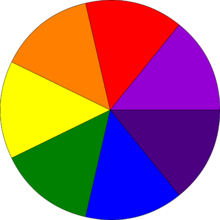
Back قرص نيوتن Arabic Disc de Newton Catalan Disco de Newton Spanish Disque de Newton French דיסק ניוטון HE न्यूटन चक्र Hindi Disco di Newton Italian ニュートンの円盤 Japanese Newtonschijf Dutch Tarcza Newtona Polish

The Newton disk, also known as the disappearing color disk, is a well-known physics experiment with a rotating disk with segments in different colors (usually Newton's primary colors: red, orange, yellow, green, blue, indigo, and violet, commonly known by the abbreviation ROYGBIV) appearing as white (or off-white or grey) when it's spun rapidly about its axis.
This type of mix of light stimuli is called temporal optical mixing, a version of additive-averaging mixing.[1] The concept that human visual perception cannot distinguish details of high-speed movements is popularly known as persistence of vision.
The disk is named after Isaac Newton. Although he published a circular diagram with segments for the primary colors that he had discovered (i.e. a color wheel), it is unlikely that he ever used a spinning disk to demonstrate the principles of light. He referred to the mixture of colors painted on a spinning top as "dirty" and described several experiments supporting his theory.
Transparent variations for magic lantern projection have been produced.[2]
- ^ Briggs, David (12 August 2012). "Additive mixing, additive-averaging". The Dimensions of Colour. Retrieved 11 August 2018.
- ^ Greenslade, Jr., Thomas B. "Newton's Color Wheel". Instruments for Natural Philosophy. Kenyon College. Retrieved 11 August 2018.